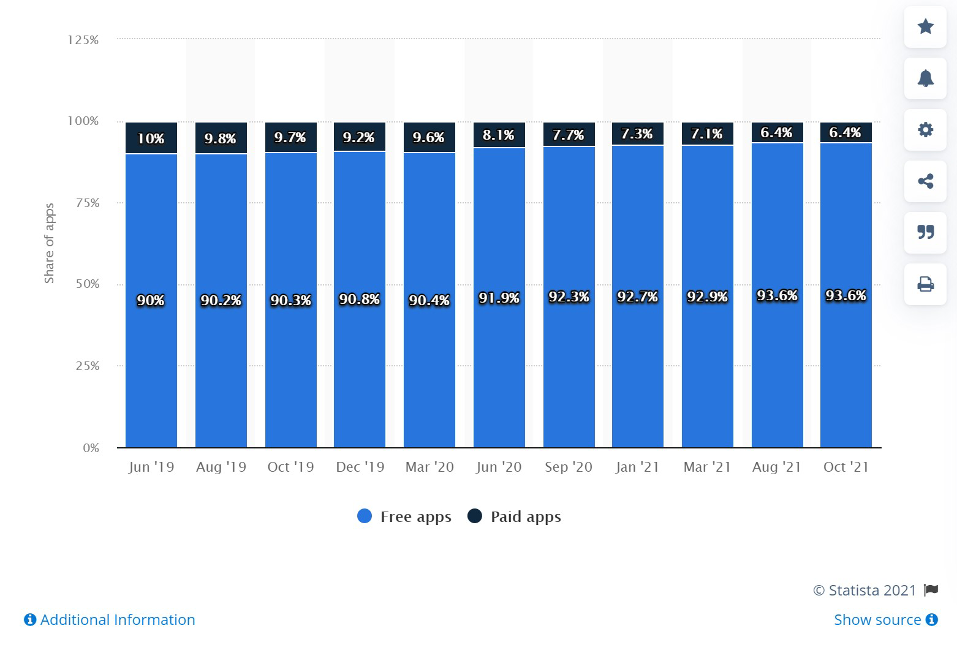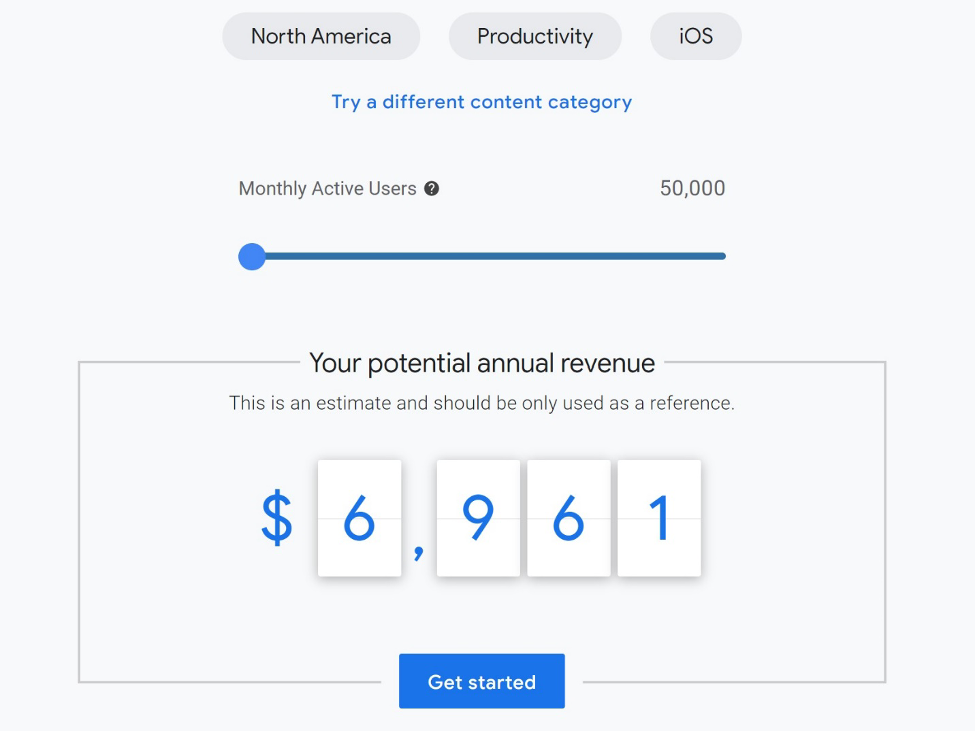Whether you’re a seasoned mobile app developer or a brand-new developer looking to break into the app development game, monetizing an app is crucial. It’s essential to explore different monetization strategies early in the development process. While you can add monetization after publishing your app, considering how you will monetize before your creation hits the app stores allows for better design and functionality decisions.
By examining various monetization models early on, you can make informed design choices that align with your chosen strategy. This guide will explore the most common ways to monetize an app and why they may be a good choice for your specific application.
Paid Apps
The first and most obvious choice is to charge a small fee for your app. While the amount you charge is something you can decide for yourself, keeping this fee relatively low would be an excellent decision. Most users have grown accustomed to downloading apps for free, and if your app costs more than a couple of dollars, you are likely to see some resistance.
Most users will be willing to buy an app for $0.99-1.99, but be careful about going much higher than that unless you have an incredibly unique and valuable app. You should also be aware of your competitors and their price points. You don’t want to sell your app for $4.99 when other similar apps sell for $1.99.
This method may be suitable for some applications, but the growing trend is toward alternate monetization models. In fact, according to Statista, the percentage of apps on iOS that are offered free is 93.6%, compared to just 6.4% paid apps. This is a trend that has only become more heavily skewed in favor of free apps each year.

In-App Ads
The most common method of monetization for a mobile app is through advertisements. In this scenario, you offer your app as a free download with all the features available to the user. To generate revenue, you can run ads, and you will be paid depending on several factors—including ad views, installs, and clicks—based on the type of ad campaign.
There are several different ad platforms, but Google’s AdMob is likely to be your best starting point. Google understands advertising strategies, as well as anyone, and its ads, are highly targeted and less intrusive than many other options.
There are a few different revenue models for advertising, and Google AdMob uses a combination of Cost Per Click (CPC), Cost Per Install (CPI), and Cost Per Mille (CPM).
- CPC – In the cost-per-click payment model, you are paid each time a user clicks an ad presented to them in your app.
- CPI – In a cost-per-install model, the ads are for other mobile apps, and you are paid when one of your users clicks on and installs the advertised app.
- CPM – In this model, you are paid for every 1000 views that your app gets.
The amount you can make will vary, but Google AdMob estimates what type of revenue you could see with a handy tool they have. You select your market, app store, and category. Then, you can view the estimated revenue based on how many monthly users you anticipate having. For example:

Free with Premium Option
You don’t have to choose just one monetization option. A hybrid model involves offering your app for free and a “premium” version of the same app at a small cost.
In this model, you can do any number of things with your premium offering. You can have a premium version that unlocks additional features not available in the app’s free version. Alternatively, you can have the premium version identical to the free version without the advertisements. The latter is a popular option, and many users will gladly pay a small fee to remove the ads from an application that they enjoy using.
In-App Purchases
Another popular method of monetizing mobile applications is using in-app purchases. This model is seen most often in mobile games, but it’s a strategy that apps in all categories can utilize.
Apps that monetize through in-app purchases are typically free to download and install, but extra features and items are “unlocked” with purchases. For example, if your app is a turn-based strategy game, you can offer the option of unlocking additional characters if the player pays to unlock this capability.
For a popular game or app, this can be a particularly lucrative strategy for monetization.
Subscriptions
Software as a service (SaaS) is an increasingly popular revenue model most often seen in desktop or web applications. The idea is to offer access to software on a subscription basis. Adobe’s new Creative Cloud can be an example of SaaS, as you can access the software so long as you have an active subscription.
A similar monetization model can be used for your mobile app as well. For instance, you can make your entire app only available to subscribers. They can download the app for free but must log in to their account to access any features. Alternatively, you can offer some features for free but have premium features available to paid subscribers.
An app that uses this model successfully is Evernote, one of the most popular note-taking apps available. It is free to create an account, but there are several subscription levels to unlock additional features.
Sponsorship and Partnerships
Another effective strategy for monetizing your app is through sponsorship and partnerships. This involves collaborating with brands or businesses that align with your app’s niche. These partners pay you to feature their content or products within your app. This can be particularly effective if you have a significant user base or a highly targeted demographic.
For example, a fitness app might partner with a health food company to offer users exclusive discounts or content. This partnership not only provides value to users but also generates revenue.
Crowdfunding
Crowdfunding has become a popular way to fund the development and monetization of apps. Platforms like Kickstarter and Indiegogo allow developers to present their app ideas to potential backers. In return for their financial support, backers receive rewards, which can range from early access to the app to exclusive features or even physical merchandise.
This model allows developers to gauge interest in their app before it hits the market and secure funding without giving up equity or taking on debt. Successful crowdfunding campaigns can also generate buzz and create a community of engaged users ready to support the app upon launch.
Data Monetization
Another less obvious but increasingly popular monetization strategy is data monetization. This involves collecting and analyzing user data to provide valuable insights to third parties. Of course, this must be done in compliance with privacy laws and with full transparency to your users.
For example, an app that tracks user fitness data could aggregate and anonymize this information to provide health and fitness companies insights. These insights can help companies better understand trends and improve their products or services. It’s crucial to ensure that your users’ data is protected and that you are transparent about how the data is being used.
Affiliate Marketing
Affiliate marketing is another potential revenue stream. This involves promoting products or services within your app and earning a commission for any sales generated through your referral. This can be particularly effective if your app’s content is related to specific products or services.
For instance, a travel app could include affiliate links to booking sites, travel gear, or accommodation services. When users make purchases through these links, you earn a percentage of the sale. This strategy provides value to your users by recommending relevant products and generates additional income for your app.
Email Marketing
Email marketing is a powerful tool for engagement and monetization. Collecting email addresses through your app can build a direct line of communication with your users. This allows you to promote new features, special offers, or content that can drive additional revenue.
For example, you can use email campaigns to upsell premium features, promote in-app purchases, or offer exclusive discounts. By segmenting your email list based on user behavior and preferences, you can deliver targeted messages that are more likely to convert.
App Store Optimization (ASO)
While not a direct monetization strategy, App Store Optimization (ASO) is crucial for increasing your app’s visibility and driving downloads. The more users you have, the more opportunities you have to generate revenue through your chosen monetization strategies.
ASO involves optimizing your app’s title, description, keywords, and visuals to improve its ranking in app store search results. A higher ranking means more visibility and potentially more downloads. Regularly updating your app and encouraging positive reviews can also boost your ASO efforts.
User Engagement and Retention
Monetizing an app isn’t just about acquiring new users; it’s also about retaining them. User engagement and retention strategies are critical for long-term success. The more engaged your users are, the more likely they are to spend money within your app through in-app purchases, subscriptions, or other methods.
To improve user engagement, consider implementing features like push notifications, in-app messaging, and gamification elements. Regularly updating your app with new content and features can keep users returning. Providing excellent customer support and responding to user feedback can further enhance retention.
Legal Considerations
When planning your monetization strategy, it’s essential to consider the legal aspects. Different monetization methods may have specific legal requirements, such as data privacy laws, advertising regulations, and consumer protection laws.
For example, if you collect user data, you must comply with data protection regulations such as GDPR or CCPA. If you use in-app advertising, you must ensure that your ads comply with advertising standards and regulations. It’s also important to clearly communicate your monetization practices to users through your app’s terms of service and privacy policy.
Final Thoughts
As an app developer, you deserve to be paid for the work you’ve put into the apps you create. Fortunately, there are many options for monetization these days. When weighing your monetization options, the most important considerations are your target audience and your app type.
For example, if your application is an enterprise-level productivity app, your target audience consists of business professionals who are more likely to pay for an app. In this instance, the simplest method may be charging your app a fee. On the other hand, if your app is a game targeted at teenagers, you may be inclined to make your app accessible and monetize through ads.
Whatever method you choose to monetize an app, it’s critical to strategize your monetization model during development so you can build your app with the proper structure already in place. Understanding your audience, being transparent with your users, and staying adaptable to market trends will help ensure the success of your app’s monetization efforts.
In conclusion, monetizing an app is a multifaceted process that requires careful planning and execution. By exploring and combining various monetization strategies, you can find the best approach for your app and maximize your revenue potential. Whether through paid downloads, in-app purchases, subscriptions, or innovative methods like data monetization and affiliate marketing, the key is to remain flexible and responsive to user needs and market changes.